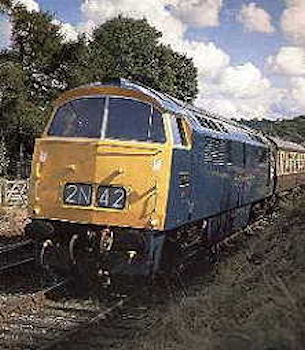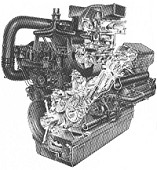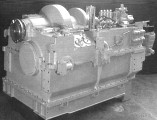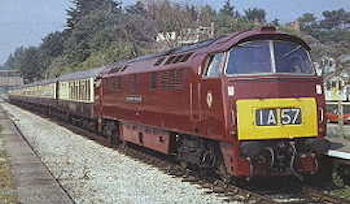|
|
The Western Region Archive |
D1000 'Western' class introduction
Copyright © by John Daniel 2013.
 The 'Western' class diesel - hydraulic locomotives came into being due to the introduction of Krauss - Maffei's experimental ML3000 3,000 bhp locomotive. This German design used the same Maybach MD650 engines and Mekydro K184 transmissions as used in the Swindon built 'Warship' class, but uprated to 1,500 bhp. Although details of the ML3000 were sent to Swindon for consideration, the Western Region decided to design their own locomotive from the ground up. Based around Maybach MD655 engines of 1,380 bhp and Voith L360rV transmissions, the body used the stressed - skin method of construction so successfully employed in the D800s. Voith transmissions were specified as Mekydro units were required for the 'Hymek' class and this decision was also made to spread the workload among the various suppliers. All of the engines though would be built by Bristol Siddeley Engines from their plant at Ansty, while 103 transmissions would be supplied by the North British Locomotive company and Voith Engineering of Glasgow with another 60 sets produced in Germany.
The 'Western' class diesel - hydraulic locomotives came into being due to the introduction of Krauss - Maffei's experimental ML3000 3,000 bhp locomotive. This German design used the same Maybach MD650 engines and Mekydro K184 transmissions as used in the Swindon built 'Warship' class, but uprated to 1,500 bhp. Although details of the ML3000 were sent to Swindon for consideration, the Western Region decided to design their own locomotive from the ground up. Based around Maybach MD655 engines of 1,380 bhp and Voith L360rV transmissions, the body used the stressed - skin method of construction so successfully employed in the D800s. Voith transmissions were specified as Mekydro units were required for the 'Hymek' class and this decision was also made to spread the workload among the various suppliers. All of the engines though would be built by Bristol Siddeley Engines from their plant at Ansty, while 103 transmissions would be supplied by the North British Locomotive company and Voith Engineering of Glasgow with another 60 sets produced in Germany.
The order for 74 locomotives was placed by the British Transport Commission in September 1959 just prior to the completion of the final design. Construction was to be split between Swindon, who were to build the first 35 'Westerns', and also Crewe who were to built the last 39. Various problems with the final design details meant that the first member of the class was not delivered  until December 1961, and so to relieve pressure on Swindon, the decision was taken that the last 5 of the locomotives due to built there, would be constructed at Crewe instead. Therefore, Swindon built 'Western' numbers D1000 - 29, while Crewe built numbers D1035 - 73 and D1030 - 4 in that order.
until December 1961, and so to relieve pressure on Swindon, the decision was taken that the last 5 of the locomotives due to built there, would be constructed at Crewe instead. Therefore, Swindon built 'Western' numbers D1000 - 29, while Crewe built numbers D1035 - 73 and D1030 - 4 in that order.
Initially the class were to be named after West Country beauty spots and the suggestion was that number D1000 was to become 'Cheddar Gorge' before this proposal was dropped in favour of the 'Western' names. The class also became the subject of various livery experiments. The first 'Western', D1000 Western Enterprise, was outshopped in a unique desert sand livery with wheels, roofpanels, bogies and window frames in black. Buffer beams and front skirts were painted in carmine red. The second 'Western' locomotive, D1001 Western Pathfinder, was delivered in a maroon livery with window frames in white while the buffer beams and front skirts were in yellow. The next three locomotives, D1002 - 4, were painted in the traditional Brunswick Green but with small yellow panels applied around the headcodes. The first Crewe built 'Westerns', D1035 - 8, were similarly painted. There then followed a public competition to decide the most popular livery (yes, British Railways did ask the public for their opinion sometimes) and the winning colour that the public chose was maroon. Other examples of the class were given this livery together with the small yellow panel around the headcode. One exception to this was number D1015 Western Champion, which was outshopped in a livery described as Golden Ochre with the buffer beams painted in red.
In Service.
As stated, D1000 'Western Enterprise'  entered traffic in December 1961 and was soon sent to Plymouth Laira for trials, while in February 1962, D1001 'Western Pathfinder' was chosen for various trials against the prototype of what would become the Class 47's, D0280 'Falcon'.
entered traffic in December 1961 and was soon sent to Plymouth Laira for trials, while in February 1962, D1001 'Western Pathfinder' was chosen for various trials against the prototype of what would become the Class 47's, D0280 'Falcon'.
Within a month, the first signs of a bogie design fault appeared and it was found that soft suspension between the bogies and the body frame on D1000 created excessive movement of the cardan shafts that transmit the drive from the engine to the transmission. This movement weakened the cardan shaft joints and also set up stresses within the transmission. D1001's transmissions were also inspected and the same amount of wear was discovered. Stiffening and repositioning the torque reaction arms effected a temporary repair, however in 1963, a return of the unsatisfactory riding qualities meant that all but four of the class were restricted to 80 mph. A programme of bogie modifications, including replacing the rubber side blocks with metal fittings, was begun and by April 1964, 50 members of the 'Western' class were restored to working at 90 mph.
torque reaction arms effected a temporary repair, however in 1963, a return of the unsatisfactory riding qualities meant that all but four of the class were restricted to 80 mph. A programme of bogie modifications, including replacing the rubber side blocks with metal fittings, was begun and by April 1964, 50 members of the 'Western' class were restored to working at 90 mph.
Many of the mechanical problems that effected the 'Westerns' were related to the train heating boiler, but also problems were found with the compressors and exhausters, dynostarts and engine fuel pumps. Many of the faults were blamed on Bristol Siddeley Engines who manufactured the Maybach engine under licence, and in some instances, materials appeared to have been used which were not to the design specification. One example of this was the compressors lower central shaft roller bearing which had a cheaper alternative installed, while on some of the crankcases, the wrong type of welding rod had been used in its construction.
One unusual design problem on the 'Westerns' concerned the windscreen wipers when in use at high speed. Numbers D1006 'Western Stalwart' and D1039 'Western King' were fitted with experimental rotary wipers of a design used on ships. Although these type of wipers swept away the water, they produced an opaque film on the windscreen and this restriction to the drivers vision cancelled the project.
By the late 1960's, apart from one or two engine problems, the 'Westerns' were giving sterling service. The bogies were giving 150,000 miles between general repairs while the Voith transmission was shown to be a more reliable unit compared to the Mekydro transmission on the 'Warships'. The class soldiered on into the early 1970's due to the unavailability of the English Electric Class 50, and as maintenance staff had been told to keep the 'Westerns' running without major repairs, it was not uncommon to see plumes of blue smoke from the locomotives exhausts.
Withdrawal.
The first withdrawals of the class occurred in May 1973 of numbers D1019 'Western Challenger' and D1032 'Western Marksman'. Seven other members were withdrawn during 1973 including D1017 - 20, the only 'Westerns' not to be fitted with dual brakes. 1974 saw another 11 withdrawn, however 1975 witnessed 18 withdrawals, leaving 34 of the class to run into 1976 mainly due to Class 50 shortages. When the problems with the 50's traction motors was rectified, 27 'Westerns' were withdrawn during 1976 leaving numbers D1010 / 13 / 22 / 23 / 41 / 48 / 58 remaining at the start of 1977. D1022 and D1058 had gone in January leaving five survivors, although numbers D1013 'Western Ranger' and D1023 'Western Fusilier' performed the 'Western Tribute' tour on the 26th of February. These last five 'Westerns' were all withdrawn on the 28th of February 1977, the last of the Western Region diesel-hydraulics.
Preservation.
Seven 'Westerns' have been saved for preservation, five of which were still in BR service until 28th of February 1977. They are numbers :
D1010 'Western Campaigner' although this engine masquerades as D1035 'Western Yeoman',
D1013 'Western Ranger',
D1015 'Western Champion',
D1023 'Western Fusilier',
D1041 'Western Prince',
D1048 'Western Lady', and
D1062 'Western Courier'
Specifications.
Wheel arrangement
Co-Co
Wheel diameter
3ft 7in
Weight
108 tonnes
Height
12ft 117/8 in
Length
68ft
Width
9ft
Minimum curve negotiable
4½ chains
Maximum speed
90mph
Wheelbase
54ft 8in
Heating type
Steam - Spanner Mk III
Brake force
82 tonnes
Tractive effort
72,600 lb (later 70,000 lb)
Total engine horsepower
2,700 hp
Power at rail
2,350 hp
Fuel tank capacity
850 gallons
Boiler water capacity
800 gallons